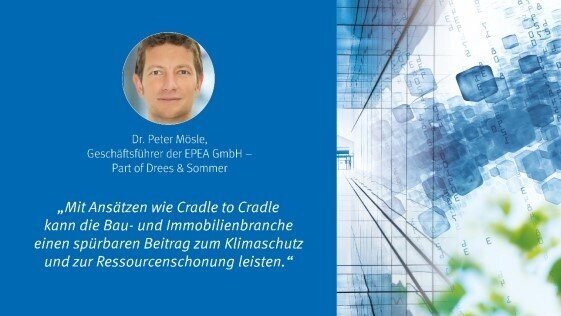Cities are proclaiming climate crises, movements such as Fridays for Future are campaigning for more environmental protection: not a day goes by now without reports on the effects of climate change and the future of our planet, together with discussion of these topics. Against this backdrop, the construction and real estate industries are also seeing a great deal of movement at present. Position papers and declarations of emergency by major professional associations such as Framework for carbon-neutral buildings and sites by the German Sustainable Building Council (DGNB), Haus der Erde (House of Earth) by the Association of German Architects (Bund Deutscher Architekten, BDA) and voluntary initiatives such as Architects for Future demonstrate that the industry is becoming more and more aware of the seriousness of the situation and now wants to make far-reaching changes. As the largest consumer of the world's raw materials and the source of immense quantities of waste, the construction industry has greater responsibility than almost any other sector to provide rapid and effective solutions to climate issues and resource problems.
Focus on Recycling-Enabled Construction
Although energy efficiency, CO2 savings and the use of renewable energy are now practically standard requirements in many construction projects, this is only half the battle in relation to the overall problem. The other part refers to how we deal with the scarcity of raw materials and the trashing of our planet Earth. Without mindsets such as Cradle to Cradle® (C2C), there is no solution to this problem in sight. The C2C design concept represents virtually perpetual circulation of resources in closed cycles, thus gross value added can be decoupled from resource consumption. This is the basis for achieving a substantial improvement in climate protection.
For example, interdisciplinary research teams are increasingly dealing with material cycles; manufacturers and producers are working on the development of completely recyclable and compostable building materials, using concepts such as C2C; while more and more building owners and developers are already using them in their projects. Just as the topic of energy suddenly came to the fore in the late 1970s with the oil crisis, the development and use of recycling-enabled materials are now coming into the focus of industry and the construction sector.
And just as the profession of an energy consultant became necessary at that time, today it is apparent that a new discipline (the circular engineer or the materials planner) is needed to meet the challenges, through integrative interaction with the architect and building owners and/or developers. This new planning discipline will deal comprehensively with the major task of materiality in the project. To date, the building industry has lacked the necessary specialist expertise, and the classic engineering disciplines cannot fully cover the know-how that is required.
Innovation Partner for all Material Questions in the Project Needed
Against this background, architectural firms and planning offices in particular are faced with the major task of responding to the growing demands of clients. They must also rethink their concepts: to what extent can the used resources be recycled, and how sustainable in a positive sense are the processes. They need a contact person in projects to support them in developing innovative design strategies, providing them with information on jointing techniques and the chemical composition of materials. The person must also be familiar with the material properties of building products. Planning skills are another requirement: a chemist without planning and construction process knowledge is unsuitable for this role. As a result, this function will be performed by a circular engineer or a materials planner in the future. This role is almost non-existent in this form at present, since this type of training is still not available at hardly any institute of higher education. EPEA GmbH – Part of Drees & Sommer is an example of a company that has the required broad base of technical expertise. For several years now, its experts have been integrating the Cradle to Cradle design principle into construction projects, testing and optimizing products for their ability to be recycled, carrying out C2C product certifications as an accredited assessor and working closely with product manufacturers.
Nevertheless, it is not enough for only a few people to deal with these issues. Everybody is needed, everybody has to deliver. One thing is certain: if the construction and real estate industry wants to make a really noticeable contribution to climate protection and resource conservation, there is no way around the Circular Economy. Another certainty: at this point in time, we can no longer afford to think long and hard, to wait and see what others are doing, and to approach these issues gradually. It is a race against time!
